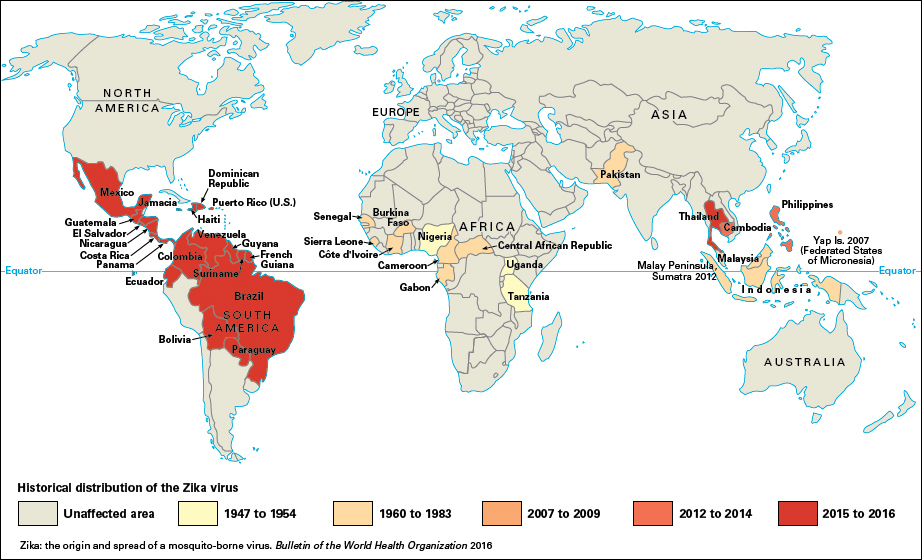Zika virus is a microorganism that causes an illness linked to serious birth defects in humans. The virus was named after the Zika Forest near Lake Victoria in Uganda , where scientists first discovered it in 1947. Since its discovery, the Zika virus has spread slowly from Africa to Asia and to several islands in the Pacific Ocean . Since 2015, the Zika virus has caused extensive outbreaks of disease in Central and South America and has been detected in Europe . In 2016, the first Zika infections were reported in the mainland United States.

Scientists classify the Zika virus in the flavivirus family. This family of viruses is a subgroup of a larger group called arboviruses. The flavivirus family includes several viruses that cause disease in people. Such flaviviruses include the yellow fever virus, dengue virus, Japanese encephalitis virus, and West Nile virus .
Symptoms.
Most people infected with Zika virus experience mild symptoms or no symptoms at all. About 20 percent of individuals develop symptoms 2 to 10 days after infection. These symptoms include rash, fever , joint pain, conjunctivitis (inflammation of the eye), and headache . People usually recover completely in a few days. Death from Zika virus infection is rare. In 2013, doctors in French Polynesia , in the South Pacific Ocean, observed that some Zika patients developed Guillain-Barré syndrome. This condition causes progressive muscle weakness by damaging the peripheral nervous system .
In 2015, a widespread outbreak of Zika virus infection was discovered after doctors noted a sudden and dramatic increase in certain birth defects. Brazilian health authorities observed a dramatic increase in babies born with microcephaly. In this condition, a child is born with the head smaller than normal, often with severely impaired brain development. In Brazil , several babies with this condition and their mothers showed evidence of Zika virus infection, strongly indicating a link between the virus and birth defects. Genetic (hereditary) material from the Zika virus has also been isolated from microcephalic fetuses. Past Zika virus infection outbreaks in Africa and Asia, however, had not been strongly associated with reported increases in microcephaly among births. 
In April 2016, the World Health Organization (WHO), an agency of the United Nations, determined that there was sufficient scientific evidence to show the Zika virus can cause microcephaly and Guillain-Barré syndrome. Medical researchers continue to work to understand exactly how the virus causes these conditions in certain people who are infected.
Transmission.
The Zika virus is spread among humans through the bite of certain mosquitoes classified in the genus Aedes, which are common throughout tropical regions. In Africa, the virus is known to infect monkeys . Scientists often refer to infected animals as reservoirs of the disease. The Zika virus may be transmitted from person to person or from animals to people through mosquito bites. The disease may infect people who live or work in forested areas and are bitten by infected mosquitoes. Infected people may then carry the virus to urban areas, where it is transmitted to other people through mosquito bites.
Doctors have also detected Zika virus in semen, urine , and saliva . They believe it may be possible to spread the virus from person to person through close contact. Evidence also suggests that the Zika virus may be transmitted sexually between people. However, additional research is needed to confirm that the disease is spread in these ways.
Prevention and control.
There are no drugs or vaccines that can be used to treat or prevent infection with Zika virus. Medical experts advise travelers to affected regions to practice basic control measures against mosquito bites. For example, people in areas where the Zika virus occurs should limit skin exposure by wearing long sleeves and pants, and they should wear mosquito repellant as necessary during the day, when the mosquitoes that transmit the virus are known to bite. The risk of Zika infection can also be lowered by reducing mosquito populations through the use of insecticides and by eliminating pools of standing water, in which mosquitoes may breed. 
History.
Medical researchers monitoring the yellow fever virus first discovered the Zika virus in Uganda in 1947. They first isolated the Zika virus from an infected monkey. The virus was later isolated from Aedes mosquitoes. Doctors conducting blood tests in the 1950’s found that some people in Africa carried antibodies (proteins that give protection against specific infections) for the Zika virus. In 1964, a researcher reported isolating the virus from his own blood after getting sick while studying Zika. Later studies revealed evidence of infection in other African countries as well as several countries in Asia.
The Zika virus spread beyond Africa and Asia in 2007, when an outbreak of the infection occurred in the Yap Islands of the western Pacific Ocean. In 2013, an outbreak of Zika virus happened in French Polynesia. In May 2015, officials confirmed that the virus had spread to Brazil. The virus detected in Brazil is closely related to Zika virus varieties known from Asia. By 2016, the Zika virus had been detected in the United States and more than 50 other countries.
